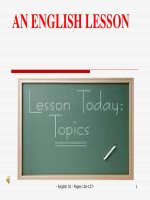unit 12 music date period 01 instruction to studying and testing i aims give students opportunities to know the ways to study to do the tests and what to prepare for the new school year ii objectives
Bạn đang xem bản rút gọn của tài liệu. Xem và tải ngay bản đầy đủ của tài liệu tại đây (108.57 KB, 9 trang )
<span class='text_page_counter'>(1)</span><div class='page_container' data-page=1>
<b>I. Aims: </b>
Give students opportunities to know the ways to study, to do the tests and what to prepare
for the new school year.
<b>II. Objectives:</b>
By the end of the lesson, students will be able to to know the content, the objectives and
the curriculum of “English 10- Immediate” book.
<b>III. Teaching aids:</b>
Textbook, board, chalk.
<b>IV. Procedure:</b>
Content Teacher’s activities Students’s activities
<b>I. Warm up (5 )</b>
’
Game: Hangman
<b>II. Presentation </b>
<b>(35 )</b>
’
<i><b>1. Content </b></i>
- 6 themes in 16 units
and 6 tests
- 5 parts (periods) in
an unit: Reading,
speaking, listening,
writing and language
focus ( Grammar and
pronunciation)
- There are 105
periods in the school
year, 54 per in 1st <sub>and</sub>
51 in 2nd <sub>term</sub>
<i><b>2. Requirements</b></i>
<b>III. Summary (5 )</b>
’
- Let students play the game “
Hang man”
- Gives the clue to help students
to guess the words.
This word contains 7 letters
<i> It is a noun</i>
<i> It is the name of a subject</i>
<i>you study at school</i>
- Asks students to take a look at
the text book and list out all the
name of the units they are to
learn at this grade.
“ How many units are you to
<i>learn at this grade?Give their</i>
<i>name”</i>
- Then asks them classify these
units into themes.
- Give the requirements of the
subject:
- For every period students
should be active to study and
get knowledge through
collective activities: Pair/group
work.
- There must be two kinds of
note book: one for theory and
another for homework.
- Test yourself (after 2 or 3
units) must be done
- Summarize the main points of
- Play game
<b>E_ N_ G_L _I _S _ H_</b>
<b>- Look at the textbook and </b>
give answers
+ Ss1: 16 units
+ Ss2: 6 themes.
They are: Daily life, People’s
background, Information and
technology, Nature and
conservation, Sports and
Entertainments, Cities and
Historical places.
- Listen and take notice
</div>
<span class='text_page_counter'>(2)</span><div class='page_container' data-page=2>
<b>Date...</b>
<b>Unit 1: A day in the life of…</b>
<i><b>Part A: Reading</b></i>
<b>I. Aims: </b>
Give students opportunities to:
Practise reading skills (scanning, skimming and guessing the meaning of new words).
Improve the knowledge about the farmer’s daily routine
<b>II. Objectives:</b>
By the end of the lesson, students will be able to:
Improve their reading skills (scanning, skimming and guessing the meaning of new
words).
Have more imformation about the farmer’s daily routine
Increase their vocabulary about routine
<b>III. Teaching aids:</b>
</div>
<span class='text_page_counter'>(3)</span><div class='page_container' data-page=3>
in textbook (page 12)
Unit 1: A day in the
life
…
Part A: Reading
I. New words:
1. plough (v)
2. Harrow (v)
3. Plot of land(n)
4. Peasant
5. Transplant
picture in textbook (page 12)
and answer the question:
<i>+ What can you see in this</i>
<i>picture?</i>
<i>+ What is the farmer doing?</i>
<i>+ Where is he working now?</i>
<i>+ Is his work hard or easy?</i>
Lead in : “Today we are going
to read about a day in the life of
a farmer?”
- Ask students to look at the
passage in 1 minute and find the
new words
<b>Present new words:</b>
1
<i>. Plough</i>
(n) ( Picture)
- Look at the picture and
answer the question:
<i>What is he doing?</i>
<i>- He is ploughing</i>
- Read aloud this word 3
times
- Ask students to repeat it 3
times
- Write down this word and
its meaning on the board
<i>Plough (v): </i>
- Ask one students to read
aloud and say its meaning.
- Do the same with other
words
answer teacher's questions.
<i>+ There is a farmer and a</i>
<i>buffalo</i>
<i>+ He is ploughing.</i>
<i>+ He is working on the field.</i>
<i>+ I think his work is hard.</i>
<b>- Find the new words</b>
<b>- Answer</b>
<b>- Listen to teacher</b>
<b>- Repeat</b>
<b>- Copy into the notebook</b>
<b>- Read aloud and say its </b>
<b>meaning</b>
</div>
<span class='text_page_counter'>(4)</span><div class='page_container' data-page=4>
<b>Date...</b>
<b>Unit 1: A day in the life of…</b>
<i><b>Part B: Speaking</b></i>
<b>I. Aims: </b>
Give students opportunities to:
Practise speaking skills (accuracy and fluency)
Talk about the student’s daily routine
<b>II. Objectives:</b>
By the end of the lesson, students will be able to:
Improve their speaking skills (accuracy and fuency)
Talk about the student’s daily routine.
<b>III. Teaching aids:</b>
Textbook, pictures in the textbook, board, chalk.
<b>IV. Procedure</b>
Content Teacher’s activities <b>Students s activities</b>’
<b>I. Warm up (5 )</b>
’
Game: Network
English Maths
Physics …….
Unit 1: A day in the life
of
…
.
Part B: Speaking
<b>I. Task 1</b>
Ask and answer and
answer question with a
partner, using the
information from the
timetable
Example:
A: <i>What time does Quan</i>
<i>have a….. lesson on</i>
<i>Monday?</i>
B: <i>(He has a…. lesson) at</i>
<i>.. </i>
<i>…</i>
A: <i>What lesson does</i>
<i>Quan have at ...on</i>
<i>Monday?</i>
B: <i>(At… on Monday, he</i>
- Divide the class into 2 group
(A and B)
- Ask each group to list all the
name of the subjects they learn
at school in 3 minutes
- The group with more words
within a limited time will be the
winner
- Call on 2 representatives to
write their result on the board
- Check and decide the winner
Lead in: “<i> Today, we are going </i>
<i>to talk about a daily life of a </i>
<i>student</i>”
- Ask students to read the
timetable (page 15)
- Call on 2 students to read
aloud it in front of the class
- Check the meaning of
timetable
- Ask students to work in pair
and do task 1
- Make a model:
- Call on 1 student and ask:
<i>+ What time does Quan have </i>“
<i>a Maths lesson on Monday?</i>”
<i>+ What lesson does Quan </i>“
<i>have at 8:55 on Monday?</i>
- Ask students to do the same
and ask and answer question,
using the information from the
- Work in group
-Listen to teacher
- List all the name of the
subjects in 3 minutes
- Write the results on the board
- Listen to the teacher
- Read the timetable
- Read in front of the class
- Answer
- Work in pair
- Listen to teacher
- Answer:
+ At 8:55 and 9:55
+ a Maths lesson
</div>
<span class='text_page_counter'>(5)</span><div class='page_container' data-page=5>
<b>II. Task 2</b>
Talk about Quan’s
activities, using the
pictures (page 15)
Example:
A: <i>What does Quan do at</i>
<i>4:30 p.m?</i>
B: <i>He watches T.V</i>
<b>III. Task 3</b>
Tell your classmates about
your daily routine
Example
A: <i>What time do you get</i>
<i>up?</i>
B: <i>I get upat 6 oc lock</i>’
A: <i>What do you often do</i>
<i>in the morning?</i>
B: I <i>go to school</i>
<b>IV. Summary (5 )</b>
’
- Check the meaning and
pronounciaion
- Ask students to work in pair
and talk about Quan’s activities,
using the picture
- Make model:
- Call on 1 students and ask:
<i>What does Quan do at 4:30 </i>
“
<i>p.m?</i>”
- Ask students use the simple
present
- Ask students to do the same
and ask and answer question
about Quan’s activities in
minutes
- Call on some pairs to ask and
answer in front of the class
- Check the meaning and
pronounciaion
- Ask students to work in group
of 3 or 4
- Ask them to ask and answer
about their friend’s daily routine
- Make model
- Call on 1 student and ask:
<i>+ What time do you get up?</i>“ ”
<i>+ What do you often do in the </i>“
<i>morning?</i>”
- Ask student to do the same and
do task 3 in minutes
- Call on some students to talk
their daily routine in front of the
class
- Check the meaning and
pronounciaion
- Summarize the main points of
the lesson.
- Ask student to prepare the new
lesson
- Homework: “ Write a passage
(100 words) about your daily
routine.
- Listen to the teacher
- Listen to teacher
- Answer:
<i>He watches TV</i>
“ ”
- Listen to the teacher
- Ask and answer in minutes
- Ask and answer in front of the
class
- Listen to the teacher
- Work in group of 3 or 4
- Listen to teacher
- Answer
+ I get up at 6 o’clock
+ I go to school
- Ask and answer about the
friend’s daily routine
- Talk their daily routine in
front of the class
- Listen to teacher
</div>
<span class='text_page_counter'>(6)</span><div class='page_container' data-page=6>
<b>Date...</b>
<b>Unit 1: A day in the life of…</b>
<i><b>Part B: Listening</b></i>
<b>I. Aims: </b>
Give students opportunities to:
Practise speaking skills (accuracy and fluency)
Talk about the student’s daily routine
<b>II. Objectives:</b>
By the end of the lesson, students will be able to:
Improve their speaking skills (accuracy and fuency)
Talk about the student’s daily routine.
<b>III. Teaching aids:</b>
Textbook, pictures in the textbook, board, chalk.
<b>IV. Procedure</b>
Content Teacher’s activities <b>Students s activities</b>’
<b>I. Warm up (3 )</b>
’
Pre-question
Unit 1: A day in the life
of
…
.
Part C: Listening
<b>I. New words (7 )</b>
’
<i>1. Present new word</i>
1. District (n) (Example)
2. Drop(v) (Picture)
3. Passengers (n) (Picture)
4. Pedal (Translation)
5. Food stall (n)
- Ask students to answer the
questions:
1<i>. Have you ever travelled by </i>“
<i>cyclo?</i>”
2<i>.</i>“<i>When was it?</i>”
3<i>.</i>“<i>Do you think that it is </i>
<i>interesting to travel by cyclo?</i>”
4<i>. Which do you prefer, going </i>“
<i>by bicycle or by cyclo? Give </i>
<i>reasons .</i>”
5<i>. What do you know about a </i>
<i>day in the life of a cyclo driver</i>
Lead in: “<i>To have more </i>
<i>information about a cyclo </i>
<i>driver s daily routine, we are </i>’
<i>going to learn a listening </i>
<i>lesson</i>”
Instruction: “ Before listening,
I’d like to introduce some new
words”
1
<i>.District</i>
(n) ( Example)
- Look at the example:
“ I live in Hau Loc district”
- Can you guess the word
- Answer:
1<i>. Yes, I have/ No I haven t</i>’
2.
3<i>. Yes, I do/ No, I don t</i>’
4<i>. I prefer going by cyclo.</i>
<i>Because it is comfortable</i>
5. <i>I don t know</i>’
- Listen to teacher
</div>
<span class='text_page_counter'>(7)</span><div class='page_container' data-page=7>
2. Listen and repeat
II. Task 1 (10’)
You will hear Mr. Lam, a
cyslo driver, talk about his
morning activities. Listen
to his talk and number the
pictures in their correct
order
<b>II. Task 2(10 )</b>
’
Listen again. Decide
whether the statements
atre true (T) or false (F)
- Ask students to repeat it 3
times
- Write down this word and
its meaning on the board
<i>District (v): </i>
- Ask one students to read
aloud and say its meaning.
- Do the same with other
words
- Ask students to look at the
book and listen to the teacher
- Repeat 10 words
- Call on some students to read
again
- Check pronounciation
* Pre – task 1
- Ask students to look at the
picture in task 1 (page 1) and
answer the question:
“What does Mr. Lam do in this
picture?
* Doing task 1
- Ask students to listen twice
and number the correct order
- Ask students to work in pair
and compare the answer with
their partner
- Call on 2 students to write the
answer on the board
- Check and give correct answer
1. Pre- task 2
- Ask students to read and
explain 5 statements in task1
- Explain some words or phrases
which students can’t understand
- Ask ss to guess which
statements are True and which
ones are
- Call some ss to give their
guesses
- Write ss’ guesses on the board
2. Doing task 2
-Ask students to listen again
twice
- Ask 2 students to give their
answers on the board
- Give feedback and correct
answers. While play the tape T
- Listen to teacher
- Answer:
+ At 8:55 and 9:55
+ a Maths lesson
- Ask and answer question,
using the information from
the timetable in minutes
- Ask and answer in front of the
class
- Listen to the teacher
- Listen to teacher
- Answer:
<i>He watches TV</i>
“ ”
- Listen to the teacher
- Ask and answer in minutes
- Ask and answer in front of the
class
- Listen to the teacher
- Work in group of 3 or 4
- Listen to teacher
- Answer
+ I get up at 6 o’clock
+ I go to school
- Ask and answer about the
friend’s daily routine
- Talk their daily routine in
front of the class
</div>
<span class='text_page_counter'>(8)</span><div class='page_container' data-page=8>
<b>III. Task 3</b>
Tell your classmates about
your daily routine
Example
A: <i>What time do you get</i>
<i>up?</i>
B: <i>I get upat 6 oc lock</i>’
A: <i>What do you often do</i>
<i>in the morning?</i>
B: I <i>go to school</i>
<b>IV. Summary (5 )</b>
’
should pause the tape to explain
the answers.
- Compare to the ss’ guesses
- Ask students to work in group
of 3 or 4
- Ask them to ask and answer
about their friend’s daily routine
- Make model
- Call on 1 student and ask:
<i>+ What time do you get up?</i>“ ”
<i>+ What do you often do in the </i>“
<i>morning?</i>”
- Ask student to do the same and
do task 3 in minutes
- Call on some students to talk
their daily routine in front of the
class
- Check the meaning and
pronounciaion
- Summarize the main points of
the lesson.
- Ask student to prepare the new
lesson
- Homework: “ Write a passage
(100 words) about your daily
routine.
</div>
<span class='text_page_counter'>(9)</span><div class='page_container' data-page=9></div>
<!--links-->









